Automated pool cleaner
An automated pool cleaner is a vacuum cleaner intended to collect debris and sediment from swimming pools with minimal human intervention. Popularly dubbed a "creepy-crawly", it is one of several types of swimming pool vacuum cleaners. Other major types are battery-powered or manually powered wands, which are generally used for smaller pools and hot tubs, and battery-powered, handheld/extended reach pool and spa vacuums. The latter are powered by rechargeable batteries and can be hand held attached to a telescopic pole used for extended reach. These are used for small to medium-sized pools, larger spas, and to spot clean larger pools.[1]
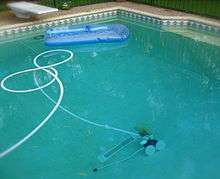
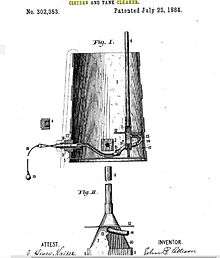
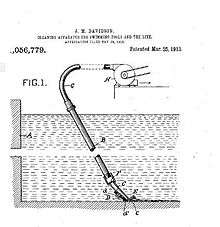
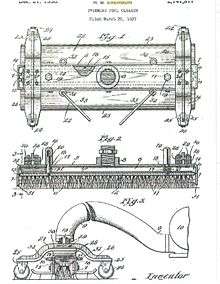
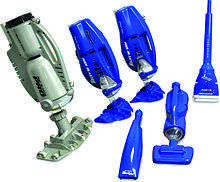
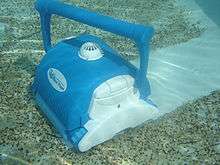
.jpg)
History
Evolution
Swimming pool cleaners evolved from two areas of science: development of the water filter and early cistern cleaners. The forerunner of today's pool cleaners were cistern cleaners. These developed from necessity to clean pools and cisterns throughout history, such as in the Roman Baths, which were known for their elaborate cisterns. They were prevalent in early America as well. The United States Patent and Trademark Office makes reference to a cistern cleaner patent filed (though never issued) as early as 1798.
In 1883 John E. Pattison of New Orleans filed an application for a "Cistern and Tank Cleaner" and the first discovered patent was issued the following year.[2] It swept and scraped the bottom of a cistern or tank, and through a combination of suction and manipulation of the water pressure was able to separate and remove sediment without removing the water. Over the next 20 years his invention was improved on numerous occasions. Many pool cleaner patents issued in the modern era refer to some of the cistern cleaners as predecessors of their invention.
Early models
The first swimming pool cleaner was invented in 1912 by Pittsburgh, Pennsylvania citizen John M. Davison. On November 26, 1912, he submitted a patent application to the United States Patent and Trademark Office entitled "Cleaning Apparatus For Swimming Pools And The Like," patent number 1,056,779 that was issued on March 25, 1913.[3]
The first suction-side pool cleaner was invented by Roy B. Everson of Chicago in 1937, which he entitled "Swimming Pool Cleaner".[4]
Nineteen years later, the first suction-side pool cleaner was the work of Joseph Eistrup of San Mateo, California, who called his invention simply "Pool Cleaner".[5]
Two years later, the "Automatic Swimming Pool Cleaner" was created by Andrew L. Pansini of Greenbrae, California, founder of Jandy Corporation. This was the first truly automatic pool cleaner. and as patent Number 3,032,044 was touted by Pansini as "effective to remove the scum, dirt and other accumulations from both the bottom and side walls of a pool to disperse foreign matter in the water for removal therefrom by normal pump-filter system of the pool."[6]
The first robotic pool cleaner which used electricity was the work of Robert B. Myers of Boca Raton, Florida in 1967, who filed a patent.[7]
A third development was the pressure-side cleaner. This was invented by Melvyn Lane Henkin of Tarzana, California in 1972. His "Automatic Swimming Pool Cleaner, United States Patent Number 3,822,754" used three wheels to allow the machine "to travel underwater along a random path on the pool vessel surface for dislodging debris therefrom".[8] The design is used as the Polaris Pool Cleaner, a commonly used pool cleaner amongst modern pool owners.[9]
Independently from his American counterparts Ferdinand Chauvier, a hydraulics engineer who emigrated to South Africa from the Belgian Congo, introduced the Kreepy Krauly in Springs, South Africa in 1974.[10]
Types
There are three main types of automated or automatic swimming pool cleaners, classified by the drive mechanism and source of power used: a suction side cleaner, a pressure side cleaner, and an electric robotic cleaner.[11][12]
Suction-side
In this type, water pumped out of the pool via its skimmer or drains is used for locomotion and debris suction and returned after being filtered via pool return or outlet valves. This is the least expensive and most popular type. It traces a random course. This type of cleaner is usually attached via a 1.5 inch hose to a vacuum plate in the skimmer, or to a dedicated extraction or "vac" line on the side of the pool. The suction action of the pool's pump provides motive force to the machine to randomly traverse the floor and walls of the pool, extracting dirt and debris in its path. The first automatic pool cleaner was a suction cleaner.
These are the least expensive and most widely used pool cleaners with purchase costs ranging in the $100–$300 price range. They are powered solely by the main pump of the pool and utilize the pool's filter system to remove dirt and debris from the water. Suction-side cleaners are best suited for screened-in pools or those with light debris such as sand. Large amounts of debris or bigger debris such as leaves and sticks can easily clog the unit itself or the pump basket. These machines effectively diminish the suction of the main pump - using them will increase the electricity costs and require the main pump and filter system to be serviced more frequently. There is minimal maintenance and part replacement costs on these devices over time.
Pressure-side
In this design, pool water inflow is further pressurized using a secondary "booster" pump on most but not all models. This high-pressure water is used for locomotion and debris suction, employing the venturi effect. It traces a random course. The requirement of a booster pump makes this type the highest in electricity use of the three types of pool cleaners.
The pressure causes turbulence in the water, distributing some debris on the floor and walls of the pool, some of which is re-floated to the pool surface and then sucked into the main filter through the skimmer inlets. A portion of the dirt and debris is caught in an attached filter bag. Pressure-side cleaners are better suited for handling a heavy amount of debris. They are also better for large debris such as leaves, acorns, and sticks. The purchase cost of this type of cleaner range from a minimum of $200 to about $700 plus the costs of the booster pump, usually over $200. Some more sophisticated models can cost over $1,000.
Both suction-side and pressure-side cleaners are dependent on the pool's main pump and filter system to remove contaminants from the pool water, so cannot remove particles smaller than the pore size of the pool's existing filter element. Such elements can be made of sand, diatomaceous earth, zeolite or other natural or synthetic materials. That particle size ranges from under 5 µm for diatomaceous filters to well in excess of 50 µm for sand filters. Disadvantages of these types of pool cleaners are the additional electricity use, and filtration limitation by the pore size of the main filter element, as well as the time and effort needed to attach the device to the ports that connect to the main pump and filter, and the increased burden of maintenance time and expense on the pool's mechanics.
Electric robotic
These cleaners are independent from the pool's main filter and pump system and are powered by a separate electricity source, usually in the form of a set-down transformer that is kept at least 10 feet (3.0 m) from the pool. They have two internal motors: one to suck in water through a self-contained filter bag and eject the filtered water back into the pool. The second is a drive motor that is connected to tractor-like rubber or synthetic tracks and "brushes"[13] connected by rubber or plastic bands via a metal shaft.[14] The brushes, resembling paint rollers, are located on the front and back of the machine and help remove contaminant particles from the pool's floor, walls (and in some designs even the pool steps) depending on size and configuration. They also direct the particles into the internal filter bag.
An internal microchip is programmed to control the drive motors. The chip will cause the machine to change direction when it reaches a wall or the water surface after climbing the pool walls.
These machines may also be directed by sensors located in the bump bars which, on contact with objects such as a wall, cause a reverse in direction, with a small offset allowing it to move one machine's width over on each crossing of the pool. The delay timer is an important feature for many pools, as many switch off a number of circulation pumps during the night to allow suspended particles to settle on the bottom of the pool; after a couple of hours the pool cleaner begins its cleaning cycle. This cleaning cycle is set up to complete before the pumps are turned back on. Though not necessary for adequate pool cleaning, this feature saves energy and improves cleaning efficiency.
In order to move forward and backward and negotiate walls and steps electric robotic cleaners rely on three natural principles, traction and movement caused by the drive motor and tracks, buoyancy created by the large areas inside the machine that fills with air, and the force resulting from the high pressure of water being emitted from the top of the machine that pushes it against the floor and walls. Some electric robotic machines use brushes made out of polyvinyl alcohol (PVA) Polyvinyl alcohol that has an adhesive quality that allows the unit to almost cling to the walls, steps and floors. They also are resistant to dirt and oil, improving lifespan over rubber or other synthetic materials.
The combination of these three natural principles along with an internal mercury switch that tells the microchip that the unit has gone from a horizontal to vertical position as it climbs a wall allows it to change direction from ascending to descending the wall at pre-programmed intervals based on the average height of a pool walls. Some machines have delayed timers that cause the robot to remain at the water line, where more dirt accumulates, for momentarily resulting in a scrubbing action, much like the wheels of a powerful automobile spinning or peeling out.
The major benefits of these machines are efficiency in time, energy, and cleaning ability as well as low maintenance requirements and costs. The major disadvantage is purchase cost which can range from $1,000 to $1,500.[15] The smart navigation system on the product makes it possible to cover the entire area with ease.[16] Limited warranties and specialized internal parts mean repairs can be costly. Therefore, robotic pool cleaners require regular and specific maintenance.
Commercial versions
All commercial pool cleaners are electric robotic and can range in price from a little over $1,000 to upwards of $15,000. They closely resemble residential models but in addition to their addition size they are made with heavy duty components and often more sophisticated computer guidance and on and off systems. In the US, commercial pool cleaners need to be certified by the National Spa Pool Foundation (NSPF) as Certified Pool Operators (CPO).[17]
Controlling legislation
There have been attempts for nearly 100 years to mandate the use of pool cleaners, primarily addressed to public pools. The Centers for Disease Control and Prevention in Atlanta, Georgia, on a grant provided by the National Swimming Pool Foundation (NSPF), is about to publish the first uniform Model Aquatic Health Code (MAHC). Included is a section on pool filtration proposed regulations directed to the nation's 3200+ state and local agencies that enforce laws and ordinances relating to the operation of swimming pools and spas.
Historical perspective
The proposed MAHC is not the first attempt to propose a uniform aquatic health code. The credit for that goes to the American Public Health Association(APHA) which 100 years ago recognized the dangers of improperly maintained aquatic facilities and formed a committee in 1918 that, for the next 66 years, issued eleven so-called "Swimming Pools and Other Public Bathing Places Standards For Design, Construction, Equipment And Operation" recommended ordinances and regulations. But for a variety of reasons none of these recommendations were adopted, at least not formally or completely adopted.
Uniform Aquatic Health Code
The APHA has tried to develop a uniform aquatic health code, or what it referred to for years as referenced above, and published short reports annually from 1920 through 1925 that it simply referred to as "Report of the Committee On Bathing Places". and finally in 1926 [18] published in its journal its first comprehensive report it called "Standards for Design, Construction, Equipment and Operation" for "Swimming Pools and Other Public Bathing Places". Twelve others were published through 1981. However, its lack of authority to enforce them is implied by the changing description of what was limited to their recommendations or suggestions and the expressed purposes in issuing them.
Reports
- In 1957, it referred to its report as "Recommended Practice for Design, Equipment and Operation of Swimming Pools and Other Public Bathing Places".[19]
- In the most comprehensive one since 1926 and until it stopped issuing them in 1981 it referred in 1964 to its report as "Suggested Ordinance and Regulations Covering Public Swimming Pools" and in 1970 one for "Private Swimming Pools". Its last report in 1981 was called "Public Swimming Pools: Recommended Regulations for Design and Construction, Operation and Maintenance". In 1926 appears the committee believed its standards would be adopted by the empowered jurisdictions, although who they were never mentioned in the report.
- In 1964 the boldest move of all took place as it presented its recommendations in the form of proposed ordinances and regulations and in the Forward concluded: "State and local governments who desire to enact this Suggested Ordinance and Regulations Covering Public Swimming Pools a useful resource".
New York City Meeting, 1912
In 1912, coincidentally the same year when the United States Patent and Trademark Office issued the first patent for a swimming pool cleaner, the Sanitary Engineering Section of the American Public Health Association (APHA) convened in New York City to lay the groundwork for the first recommended pool and spa regulations. As reported in the American Journal of Public Health in April 1912 a meeting was held in Havana the previous December and at the New York meeting among the subjects that the committee was to be studying was "Hygiene of swimming pools".[20]
Six years later a committee on swimming pools was appointed at the APHA's annual meeting in Chicago and in 1920 a similar committee was appointed at the meeting in Washington, D.C. In 1921 and periodically over the next seven decades until the work of the APHA on this subject matter went through a series of divisions and consolidations, diverted elsewhere its committees and joint committees with other health-orientated public and quasi-public organizations issued proposed ordinances and regulations in the form of unenforceable recommendations. Despite their intended and published goals, none became law, uniform, much less national.[21]
None of the proposed Standards included more than a passing reference of the need to properly clean a pool. A few, but curiously not all of these recommended ordinances and regulations, related to the use of a vacuum, although the first that included any specificity in 1923 at least required a certain level of clarity. The 1921 report, barely a few pages in length, made this reference to the need to clean the pool.
Pool cleaning is done by completely emptying the pool an average of twice weekly and scrubbing with stiff brushes and soap. Hose flushing follows the scrubbing. After the flushing outlet is opened, the well turned on and clean water allowed to water over the floor of the drains, etc...
The 1923 report of the American Journal of Public Health, Sanitary Engineering Section American Public Health Association read before the Sanitary Engineering Section of the American Public Health Association at the Fifty-second Annual Meeting at Boston, Massachusetts, October 8, 1923. slightly longer, but still very brief stated:
Section 3. Clearness: At all times when the pool is in use the water shall be sufficiently clear to permit a black disk six inches in diameter on a white field, placed on the bottom of the pool at the deepest point, to be clearly visible from both sides of the pool when the water is quiet.
It further stated:
No swimming pool shall be opened to the use of bathers on any day until all visible dirt (not stains) on the bottom of the pool and any visible scum or floating matter on the surface has been removed. Scum and floating matters may be infectious material and should always be removed as soon as possible after they are observed.
Therefore, in 1921 it was recognized that infectious material, namely pathogens collect in the pool and should be removed.
It was not until 1926 twelve years after the organization recognized the need to address swimming pool "hygiene" and eight years after the committee was organized that the first true report was issued and later published in the Journal of the American Public Health Association. Of all of its reports from 1920 through 1981 the first major report by the APHA the 1926 one, written in narrative form as were the succeeding nine ones though 1957 the committee included the detailed provisions relating to pool cleaning, vacuuming and vacuums:
E. Suction Cleaner: In the opinion of the committee the only satisfactory method of removing the dirt, hair, etc., settling on the bottom of a pool is by means of a suction cleaner. As such cleaners are commonly operated by the circulation pumps; they may be classed as an adjunct to the recirculation system. When a suction cleaner is to be operated by the recirculation pump, a gate with graduated stem or other registering device should be provided for throttling the flow from the pool outlet to permit the pump to operate at maximum efficiency when the suction cleaner is in use. Fixed pipe connections for attachment of suction cleaner to pump suction should be of ample size to reduce friction to a minimum and the cleaner and all removable connections should be designed to provide a maximum velocity at the suction nozzle.
XXVI Cleaning Pool
A. Visible dirt on the bottom of a swimming pool shall not be permitted to remain more than 24 hours. B. Any visible scum or floating material on the surface of a pool shall be removed within 24 hours by flushing or other effective means
The 1964 report included the following language:
A vacuum-cleaning system shall be provided. When an integral part of the recirculation system, sufficient connections shall be located in the walls of the swimming pool, at least eight inches below the water line and "Visible dirt on the bottom of the swimming pool shall be removed every 24 hours or more frequently as required. Visible scum or floating matter on the swimming pool surface shall be removed within 24 hours by flushing or other effective means.
The CDC was founded (in 1946), followed by the Cabinet-level Department of Health, Education and Welfare (in 1953), now the Department of Health, and Human Services and its 11 operating divisions, the National Health Service Corps (in 1977) and along the way a variety of private and non-profit aquatic organizations such as the National Spa and Pool Association (in 1956), now the Association of Pool and Spa Professionals the National Swimming Pool Foundation (in 1965).
Presently a variety of states and jurisdictions that have codified the requirement of inclusion of an independent vacuum cleaner including the two states with the highest number and concentration of both residential and public pools:
California: 2010 Title 24, Part 2, Vol. 2 California Building Code. Section 3140B, Cleaning Systems:
A vacuum cleaning system shall be available which is capable of removing sediment from all parts of the pool floor. A cleaning system using potable water shall be provided with an approved backflow protection device as required by the California Department of Public Health under Sections 7601 to 7605.
— [22]
Florida:
Florida Department of Health section 64E-9.007 Recirculation and Treatment System Requirements
(12) Cleaning system – A portable or plumbed in vacuum cleaning system shall be provided. All vacuum pumps shall be equipped with hair and lint strainers. Recirculation or separate vacuum pumps shall not be used for vacuuming purposes when in excess of 3 horsepower. When the system is plumbed in, the vacuum fittings shall be located to allow cleaning the pool with a 50 foot maximum length of hose. Vacuum fittings shall be mounted no more than 15 inches below the water level, flush with the pool walls, and shall be provided with a spring loaded safety cover which shall be in place at all times. Bag type cleaners which operate as ejectors on potable water supply pressure must be protected by a vacuum breaker. Cleaning devices shall not be used while the pool is open to bathers.
— [23]
Call to action
In 2005 the CDC, in response to a growing concern and feared epidemic with the pathogen Cryptosporidium, much like the American Public Health Association did in 1912, convened many of the country's foremost medical and scientific experts to study the concern for aquatic health. As a result, in 2007 they began their quest, again much like the APHC, for a uniform aquatic health code.
Each health and safety segment has been assigned to a committee to study it and draft a proposed module open for public comment before being adopted and then recommended to the nation's 3200+ state and local health agencies that enact ordinances and regulations for swimming pools and spa and other aquatic facilities, inspect and monitor them and then enforce the regulations. Since the focus of the MAHC was to respond to the threat of Cryptosporidium the Technical Committee of Recirculation Systems and Filtration is a major focus. The University of North Carolina Charlotte Associate Professor James Amburgey is the Chairperson of the Centers For Disease Control, Model Aquatic Health Code Technical Committee on Recirculation Systems and Filtration.
Amburgey has conducted many tests to evaluation existing swimming pool filters and his conclusions have been they are extremely ineffective in most cases to help remove Cryptosporidium.[24] He is reported to be working with several manufacturers of swimming pool and spa vacuum cleaners to develop a filter bag that will result in exponential advancements in the current filter bags, cleaners and vacuums on the market.
References
- "US Patent No: 6,797,157". Patentbuddy.com. Retrieved 24 September 2013.
- "US Patent 302,353 Cistern and Tank Cleaner". Google.com. Retrieved 24 September 2013.
- "US Patent 1,056,779 Portable electric pool cleaner". Google.com. Retrieved 24 September 2013.
- "US Patent 2,141,811 Swimming pool cleaner". Google.com. Retrieved 24 September 2013.
- "US Patent 2,902,705 Pool Cleaner". Google.com. Retrieved 24 September 2013.
- "US Patent 3,032,044 Automatic swimming pool cleaner". Google.com. Retrieved 24 September 2013.
- "US Patent 3,439,368 Swimming Pool Cleaner". Google.com. Retrieved 24 September 2013.
- "US patent 3,822,754: Automatic swimming pool cleaner". Google.com. Retrieved September 22, 2019.
- "US Patent 3,822,754 Automatic Swimming Pool Cleaner". Google.com. Retrieved 24 September 2013.
- Bruton, Mike (September 23, 2011). "SA inventions clean the world's pools". Independent Online (South Africa). Retrieved September 22, 2019.
- Worthey, Randy (2008). Line by Line:How to Make the Swimming Pool Construction Agreement Work for You. Owner Pools. p. 40. ASIN B001ECQN40 – via Google Books.
- Tamminen, Terry (2007). The Ultimate Guide to Pool Maintenance (3d ed.). McGraw Hill Professional. p. 309. ISBN 978-0071470179.
- "10 Best Pool Brushes for Algae Review: Get rid of Debris in 2020". Above Ground Pool. 2019-11-26. Retrieved 2020-02-10.
- Fulcher, John, ed. (2012). Applied Intelligent Systems: New Directions. Springer. p. 189. ISBN 978-3-642-05942-1 – via Google Books.
- Vassallo, Joseph M. (June 27, 2015). "Pool Maintenance Made Easy". Las Vegas Review-Journal. Retrieved September 22, 2019.
- Ketler, Greg (January 28, 2020). "Best robotic Pool Cleaner". Retrieved January 30, 2020.
- Morgan, Kim Kyle (July 12, 2013). "Swimming pool care, repair offer wave of job potential". Houston Chronicle. Retrieved September 22, 2019.
- Report of the Joint Committee on Bathing Places of the A.P.H.A. and the Conference of State Sanitary Engineers 1926, Swimming Pools and Other Public Bathing Places Report of the A.P.H.A. and the Conference of State Sanitary Engineers, presented to the Public Health Engineering Section of the American Public Health Association at the Fifty-sixth Annual Meeting at Cincinnati, Oct. 18, 1927
- Recommended Practice for Design, Equipment and Operation of Swimming Pools and Other Public Bathing Places Prepared by the Joint Committee on Bathing Places of the Conference of State Sanitary Engineers and the Engineering and Sanitation Section of the American Public Health Association 1957
- American Journal of Public Health, Sanitary Engineering Section American Public Health Association, Volume 11, April 1912, Issue 4, Read at the Annual meeting of the Association, held in Havana, December 1911
- American Journal of Public Health, Sanitary Engineering Section American Public Health Association, Sanitary control of a public swimming pool George W. Simons, Jr., Chief Sanitary Engineer, Florida State Board of Health, Jacksonville, FLA., Read before Sanitary Engineering Section, American Public Health Association, at San Francisco, Cal.. September 17, 1920 Report of the committee on bathing places Read before the Sanitary Engineering Section of the American Public Health Association at the Fiftieth Annual Meeting, New York City, November 17, 1921, and adopted by vote of the Section
- 2010 Title 24, Part 2, Vol. 2 California Building Code. Section 3140B, Cleaning Systems
- Florida Department of Health section 64E-9.007 Recirculation and Treatment System Requirements
- James E. Amburgey, Jonathan M. Goodman, Olufemi Aborisade, Ping Lu, Caleb L. Peeler, Will H. Shull, Roy R. Fielding, Michael J. Arrowood, Jennifer L. Murphy and Vincent R. Hill, "Are Swimming Pool Filters Really Removing Cryptosporidium?' University of North Carolina at Charlotte
Further reading
- United States Bureau of the Census. Statistical abstract of the United State, 1995. 115th ed. Washington, DC: US
- Yoder J, Blackburn B, Levy DA, Craun GF, Calderon RL Surveillance for waterbome-disease outbreaks associated with recreational water—United States, Beach MJ. 2001-2002. Surveillance Summaries, October 22, 2004.
- Progress of the U.S. Model Aquatic Health Code Project World Conference on Drowning Prevention May 13, 2011 Da Nang, Vietnam
- William R. Peterson, PH.D. and Renee E. Berman A New Method For Removing and Inactivating Water-borne Patho-gens Utilizing Saline Treated Materials Coating Systems Laboratories, Inc.
- Making Waves in the Aquatics Industry 2005 International Symposium on Household Water Management, Model Health Code.
- New Code Aims at Standards for Nation's Pools
- Delaunay A. Gargala, G, Li X, Favennec, L, Ballet JJ, Quantitative Flow Cytometric Evaluation of Maximal Cryptosporid-ium parvum Oocyst Infectivity in a Neonate Mouse Model Applied and Environmental Microbiology -Volume 66, Issue 10, p. 4315.
- Huw. V. Smith, Rosely, A. B. Nicols, Anthony M. Grimason, Cryptosporidium excystation and invasion: getting to the guts of the matter Trends in Parasitology volume 21, Issue3, March 2002, pp. 133–142.
- Okhuysen PC, Chappell CL, Crabb JH, Sterling CR, Dupont HL Virulence of three distinct Cryptosporidium parvum iso-lates for healthy adult's Journal of Infectious Diseases, Volume 180, Issue 4, pp. 1275–128
- Capet C. Kapel N, Huneau JF, Magne D, Laikuen R, Tricottet V, Benhamou Y, Tome D, Gobert JG Cryptosporidium par-vum Infection in Suckling Rats: Impairment of Mucosal Permeability and Na+-Glucose Cotransport' Experimental Para-sitology. Volume 91, Issue 2, February 1999, pp. 119–125, Water Quality Criteria, 1972"
- A report of the Committee on Water Quality Criteria Environmental Studies Board, National Academy of Sciences National Academy of Engineering, Washington, D.C., 1972-EPA-United States Environmental Protection Agency. United States Environmental Protection Agency Guide, 2 Swimming Pool Architects and Building Branch at the Department for Education (DFE).
- Gordon Nichols, Rachel Chalmers, lain Lake, Will Sopwith, Martyn Regan, Paul Hunter, Pippa Grenfell, Flo Harrison, Chris Lane, Cryptosporidiosis. A report on the surveillance and epidemiology of Cryptosporidium and epidemiology of Cryptosporidium infection in England and Wales
- Jennifer L. Clancy, Karl G. Linden, Randi M. McCuin ‘‘Cryptosporidium Occurrence in Wastewaters and Control Using UV Disinfection International Ultra-Violet Association- Volume 6, Issue 3
- In Search of Crypto's Achilles Heel University of Georgia Research Magazine, University of Georgia Research Magazine
- Guidelines for Safe Recreational Water Environments Volume 2 Swimming Polls and Similar Environments World Health Organization
- Franz J. Maier A System for Fluoridating Individual Water Supplies American Journal of Public Health, Volume 48, Issue 6, June 1958
- Fiona L. Henriquez, Thomas A. Richards, Fiona Roberts, Rima McLeod and Craig W. Roberts The unusual mitochondrial compartment of Cryptosporidium parvum -X. Trends in Parasitology, Volume 21, Issue 2, February 2005
- James E. Amburgey, Kimberly J. Walsh, Roy R. Fielding and Michael J. Arrowood Removal of Cryptosporidium and polystyrene microspheres from swimming pool water with sand, cartridge, and pre-coat filters Journal of Water and Health, Volume 10, Issue 1, pp. 31–42
- Paul A. Rochelle, Steve J. Upton, Beth A Montelone and Keith Woods The response of Cryptosporidium parvum to UV light, Trends in Parasitology, Volume 21, Issue 2, February 2005, pp. 80–87
- James E. Amburgey and J. Brian Anderson Disposable swim diaper retention of Cryptosporidium-sized particles on human subjects in a recreational water setting Journal of Water and Health, Volume 9, Issue 4, September 2011, pp. 653–658
- James E. Amburgey Removal of Cryptosporidium-Sized Polystyrene Microspheres from Swimming Pool Water with a Sand Filter with and without Added Perlite Filter Media Journal of Environmental Engineering, Volume 137, Issue 12, December 1, 2011, pp. 1205–1208
- J. Lepage P. Rouvroy D, Vandepitte, J ‘‘Cryptosporidium spp., a frequent cause of diarrhea in Central Africa Bogaerts Journal of Clinical Microbiology, Volume 20, Issue 5, November 1984, pp. 874–876
- Thulin JD, Kuhlenschmidt MS, Rolsma MD, Current WL, Gelberg HB An intestinal xenograft model for Cryptosporidium parvum infection. Department of Veterinary Pathobiology, College of Veterinary Medicine, University of Illinois Urbana 61801, Infection and Immunity, Volume 62, Issue 1, January 1994, pp. 329–331
- Neutralization of cryptosporidium parvum sporozoites by immunoglobulin and non-immunoglobulin components in serum-Hill, BD. Dawson AM, Blewett, DA, Research in Veterinary Science, Volume 54, Issue 3, May 1993, pp. 356–360
- Moredun Research Institute, Edinburgh Characterization of cyclophosphamide-rat model of cryptosporidiosis. Rehg JE, Hancock ML, Woodmansee DB.'Infection and Immunity Volume 55, Issue 11, November 1987, pp. 2669–2674, Comparative Medicine Division, St. Jude Children's Research Hospital, Memphis Tennessee 38101
- James E. Amburgey, Kimberly J. Walsh, Roy R. Fielding and Michael J. Arrowood Removal of Cryptosporidium and polystyrene microspheres from swimming pool water with sand, cartridge, and precoat filters, IWA Publishing 2012
- B T Croll, C R Hayes, C J Wright, S Williams and D. Rowlands Optimisation of pool water filtration for Cryptosporidium oocyst removal and new research Swansea University, Wales, Biofilm- A Nasty that's in your Pool! Professional Pool Operators of America, 2012
- Michael Unger The Role of the Schmutzdecke in Pathogen Removal in Slow Sand and Riverbank Filtration Presenta-tions/unger_schmutzdecke.pdf, University of New Hampshire
- Equipment for Swimming Pools, Spas, Hot Tubs and Other Recreational Water Facilities. National Sanitation Foundation International Standard
- Kuan Mu Yao, Mohammad T. Habibian, and Charles R. O'Melia Water and Waste Water Filtration: Concepts and Applications. Environmental Science & Technology, Volume 5, Issue 11, November 1971